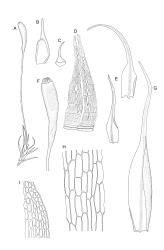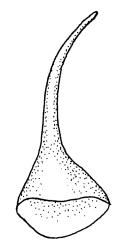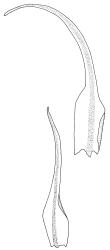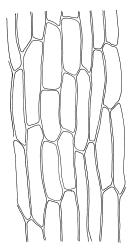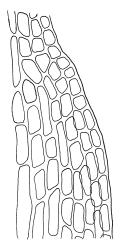- = Trematodon arcuatus Mitt. in Hooker, Handb. New Zealand Fl. 415 (1867)
- = Trematodon cheesemanii Müll.Hal., Hedwigia 37: 110 (1898)
- = Trematodon integrifolius Müll.Hal., Hedwigia 37: 110 (1898)
Plants variable in size, bright or yellow-green. Stems c. 2–6 mm, branching by innovation. Leaves erect-spreading, sheathing below, contorted when dry, gradually tapered or abruptly shouldered from a ± oblong base to an elongate subula that is narrowly laminate below but filled by the costa above and ½–⅔ the total leaf length, entire except for a few blunt teeth at apex, mostly (3–)4.5–7 mm in perichaetium, much shorter below. Laminal cells of leaf base mostly 60–105 × 15–21 µm; laminal cells of lower subula rectangular, smooth. Costa (in leaves immediately below the perichaetium) occupying c. ⅙ the width of the base and completely filling the subula, in cross-section (lower subula) with both abaxial and adaxial stereid bands.
Autoicous (or sometimes rhizautoicous). Setae c. (7–)13–15(–30) mm, slender and straight or weakly flexuose, yellow; capsules curved, mostly (2.5–)3–6(–7) mm, the neck equal or distinctly longer (to c. 1.5 × or rarely more) than the cylindric urn, weakly to strongly strumose; exothecial cells elongate; annulus apparently revoluble; operculum rostrate from a conic base, c. ⅓ the capsule length. Peristome teeth well-developed, red-brown, inserted near mouth, narrowly lanceolate, split into unequal branches nearly to the well-developed basal membrane and usually fused apically, often with other scattered perforations, 290–510 µm (excluding basal membrane), erect when dry, strongly striate. Calyptra cucullate, covering c. ½ the urn. Spores 21–33 µm, coarsely baculate-insulate.
Sainsbury 1955, pl. 14, fig. 3.
The distinctions from other N.Z. species of Trematodon are drawn in the key. In a N.Z. context, confusion is most likely with T. mackayi, particularly in older collections where the peristome is broken. Spore diameter is then the most reliable means of distinguishing these two species. As stated above, the relationship of the present species to T. longicollis Michx. is problematic.
K; NI: N Auckland (Te Aroha, Ōmahuta State Forest), S Auckland, Gisborne, Hawke's Bay, Wellington; SI: Nelson, Marlborough (Endeavour Inlet, Te Māhia, Kaikōura), Canterbury (Banks Peninsula) Westland, Otago, Southland (Milford Sound); St.
Australasian. Mainland Australia*.
On bare soil including clay, pumice, sand, and gravel. Often on vertical banks and in roughly mown areas; in the latter forming turves to at least a square metre in extent. Also occurring on sides of drains, on spoil derived from excavations, and other disturbed habitats. From near sea level (Little Wanganui River, Nelson L.D.) to c. 1300 m (Copeland Valley, Westland L.D.). Trematodon suberectus is quite tolerant of thermally heated soil. On Kermadec Is T. suberectus is a conspicuous and abundant species on pumice associated with thermal fumaroles (W.R. Sykes, pers. comm., 10 July 2001) and its abundance there is reflected in the large number of Kermadec collections in N.Z. herbaria. A collection from "near an antimony mine" on the Coromandel Peninsula suggests that some populations may be tolerant of heavy metal concentrations. Often associated with Campylopus introflexus, Ceratodon purpureus, Dicranella jamesonii and Ditrichum difficile.
The innovative branching of the stems in T. suberectus is often difficult to observe. The species is highly variable in overall stature and in capsule length; the degree of perforation of the peristome teeth also varies greatly. In most specimens the teeth are split from near their base to ½ to ⅔ their length, with the branches mostly fused at their apices. Even in single capsules, however, the degree of division varies greatly. In addition to the perforations between the two uneven branches, subsidiary perforations also occur. Such perforations are particularly numerous and conspicuous in material from Kermadec Is, including the Cheeseman material on which T. cheesemanii Müll.Hal. is based. Similar perforations can be seen in collections from scattered localities from the main islands, including T.W.N. Beckett 277 from Marlborough L.D. (the type of T. integrifolius).
Clarification of the relationship between T. suberectus and T. longicollis Michx. is beyond the scope of this Flora. Trematodon longicollis is recorded to be widespread in the northern hemisphere and the name has been applied to material from P.N.G. (Norris & Koponen 1990), and elsewhere in the Pacific (Norris & Koponen 1990; Whittier 1976). Based primarily on capsule form, many North I. collections could justifiably be assigned to T. longicollis. Material from Waimangu, S Auckland L.D. (J. Child 2517, CHR 432707), has capsules with necks nearly twice the length of the urns, spores only 19–21 µm, and some plants clearly autoicous. Other collections that could justifiably be referred to T. longicollis have been seen from Hopuruahine River, Gisborne L.D. (WELT M021268), Wairoa County, Hawke’s Bay L.D (WELT M021266), and Pōhāngina, Wellington L.D. (CHR 467074). Norris & Koponen (1990), without defining their concept of the "South Pacific", state that "In the South Pacific, one should probably assign this name [T. longicollis] to any Trematodon with a fully developed peristome, and with at least some recurvature of the leaf margin."
In N.Z., material with well-developed necks and peristomes, and relatively small spores, represents one end of a morphological gradient, and it is doubtful that any clear distinction between representative T. suberectus and T. longicollis could be drawn using morphology alone.
The names T. longescens Müll.Hal. and T. adaequans G.Roth have been applied to similar material from N.S.W. (e.g., CHR 588492, collected by Watts from Richmond River and named as T. adaequans by Brotherus). Monographic study, probably using non-traditional methods, would be needed to clarify the relationship of these species. At our present level of understanding, it is advisable to continue to apply the name T. suberectus to our most common and widespread species of Trematodon.
The sexuality of T. suberectus is not always readily demonstrated; however, with care, some plants can usually be demonstrated to be autoicous. It is probable that in such plants the terminal meristem is consumed by the formation of the perigonium and that the perichaetial shoot arises by innovation. Dixon (1914, p. 36) observed that "the male inflorescence in T. suberectus appears to be sometimes on a short basal branch, sometimes on a separate but closely connected plant (i.e., rhizautoicous)." The rhizautoicous nature of some plants probably accounts for the varying reports of the sexuality of this species.
There is no reason to question Dixon’s (1914, p. 35) conclusion that T. arcuatus Mitt. is conspecific with the present species; material so-named by Brotherus (CHR 588490) in herb. Beckett is assignable here. There is no type material of either T. suberectus Mitt. or T. arcuatus Mitt. in any N.Z. herbarium.




